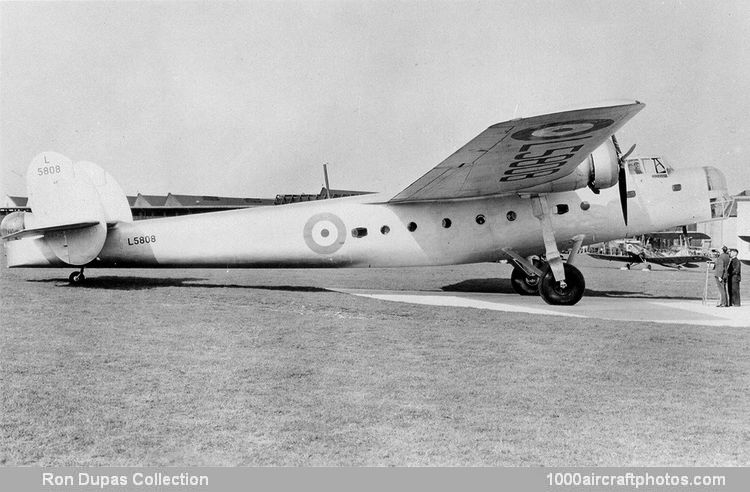09/30/2016. Remarks by Johan Visschedijk: "In 1931 the Air Ministry issued Specification C.26/31 for a twin-engined monoplane to carry 24 fully-equipped troops or an equivalent load of cargo, including spare engines or bulk fuel; it had also to carry defensive armament and be suitable for operation as a long-range bomber, to replace the Vickers Valentias of the RAF bomber-transport squadrons in Egypt, Iraq and India.
The Bristol project to meet this specification was Type 130, a high-wing twin-engined monoplane of all-metal construction with an Alclad stressed-skin fuselage developed from recent experimental work by Pollard's structural research department. The cantilever wing had seven spars with high-tensile steel flanges and Alclad sheet webs, pressed Alclad ribs being threaded on and the whole assembly riveted to the Alclad skin, giving a wing of extreme torsional stiffness.
A contract for one prototype was awarded in March 1933 and detail design continued throughout the year as construction proceeded, being proved at every stage by tests on representative riveted joints to ensure the lowest possible structure weight compatible with safe stress levels. Bristol Pegasus IIIM 3 engines of 750 hp were specified; other features included a fixed wide-track landing gear and castoring tail wheel, a monoplane tail with twin fins and rudders, and an enclosed turret with a Lewis gun in the nose, which was also the bomb-aimer's station. The tail-gunner's position was accessible from the fuselage and at first was an open cockpit with a Scarff ring, but later a cupola was added.
The prototype Bristol 130, serialed K3583, was first flown on June 23, 1935 by Chief Test Pilot Cyril F. Uwins, and with its span of 96 ft (29.26 m) was the largest aeroplane built at Filton to that date. On completion of maker's trials it went to Martlesham, where its pilot for the official trials was Flight-Lieutenant A.J. Pegg. Development testing of the 130 went on at Filton and Martlesham until 1936, by which time several improvements had been incorporated, including a change to three-bladed Fairey-Reed metal airscrews and some alteration to the tail surfaces to accommodate the auto-pilot's characteristics, also hydraulic nose and tail turrets of Bristol design, respectively Types RII and RIII, each carrying a single Vickers' K' gun. Thus modified, with more powerful Pegasus XXII engines driving Rotol variable pitch airscrews, the design became Type 130 Mark II and was officially named Bristol Bombay in February 1937.
There was no possibility of putting it into production at Filton, because of its size and current preoccupation with the Blenheim, so the contract for fifty Bombays to Specification 47/36 was placed with a new company, Short and Harland Ltd., formed at Belfast by Short Brothers and Harland & Wolff to operate a new government-owned shadow factory on Queen's Island. The first production Bombay, serialed L5808, was flown at Belfast in March 1939 and deliveries commenced thereafter to No. 216 Squadron in Egypt, which received them in September 1939. K3583 was retained for development work at Filton until 1941, wearing camouflage with yellow undersurfaces and the name "Josephine" painted on the nose.
Operationally the Bombay formed the equipment of Nos. 216, 117, 267 and 271 Squadrons. It was used in both transport and night-bomber roles in the Libyan desert campaign, returning to base in Egypt with full loads of casualties on stretchers. A few home-based Bombays were used to ferry supplies to the British forces in France in 1940, and on June 18, 1940 a French intelligence officer attached to No. 1 Squadron found a Bombay abandoned on Chateaudun airfield with a broken tail wheel. In spite of this damage he took off successfully with fifteen compatriots and flew to England to join the Free French forces, although not a qualified pilot.
Bombays of No. 216 Squadron, with full bomb racks and other improvised missiles hurled from the cabin doors, took part in the nightly bombardment of Benghazi in the autumn of 1940. On May 2, 1941 they assisted in the evacuation of Greek refugees (including the Royal Family) from Crete to Egypt, and a week later flew a detachment of the Essex Regiment behind Raschid el Ali's rebel lines at Habbaniyah in Iraq. They were active in the renewed advance into Libya in November 1941 and dropped the first Allied parachute troops on Southern Italy.
After being superseded by Lodestars in the later stages of the North African campaign, the surviving Bombays from No. 216 Squadron were transferred to No. 1 Australian Air Ambulance Unit, evacuating over 2,000 casualties from Sicily to North Africa in June 1943 and later carrying nursing sisters to Italy after the Anzio landings. They continued with casualty evacuation from Italy to Sicily, and one Bombay crew alone had carried 6,000 cases before the campaign ended more than ten years after the first Bristol 130 prototype had been ordered."
